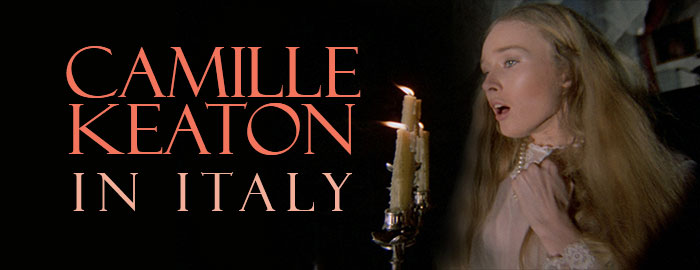
TRAGIC CEREMONY
Color, 1972, 87 mins. 14 secs.
Directed by Riccardo Freda
Starring Camille Keaton, Tony Isbert, Máximo Valverde, Giovanni Petrucci, Luciana Paluzzi, Luigi Pistilli
Vinegar Syndrome (Blu-ray) (US R0 HD), Dark Sky (DVD) (US R0 NTSC) / WS (1.85:1) (16:9),
Shoarma (R0 NTSC)
SEX OF THE WITCH
Color, 1973, 95 mins. 17 secs.
Directed by
Angelo Pannacciò
Starring Susan Levi, Jessica Dublin, Sergio Ferrero, Camille Keaton, Franco Garofalo, Gianni Dei, Donald O'Brien
Vinegar Syndrome (Blu-ray) (US R0 HD), Cinekult (DVD) (Italy R2 PAL) / WS (2.35:1) (16:9)
MADELEINE: ANATOMY OF A NIGHTMARE
Color, 1974, 102 mins. 35 secs.
Directed by Roberto Mauri
Starring Camille Keaton, Riccardo Salvino, Pier Maria Rossi, Paola Senatore, Silvano Tranquilli
Vinegar Syndrome
(Blu-ray) (US R0 HD) / WS (2.35:1) (16:9)
Though best known today in cult movie circles for her harrowing lead performance in I Spit on Your Grave (and one of its sequels decades later), 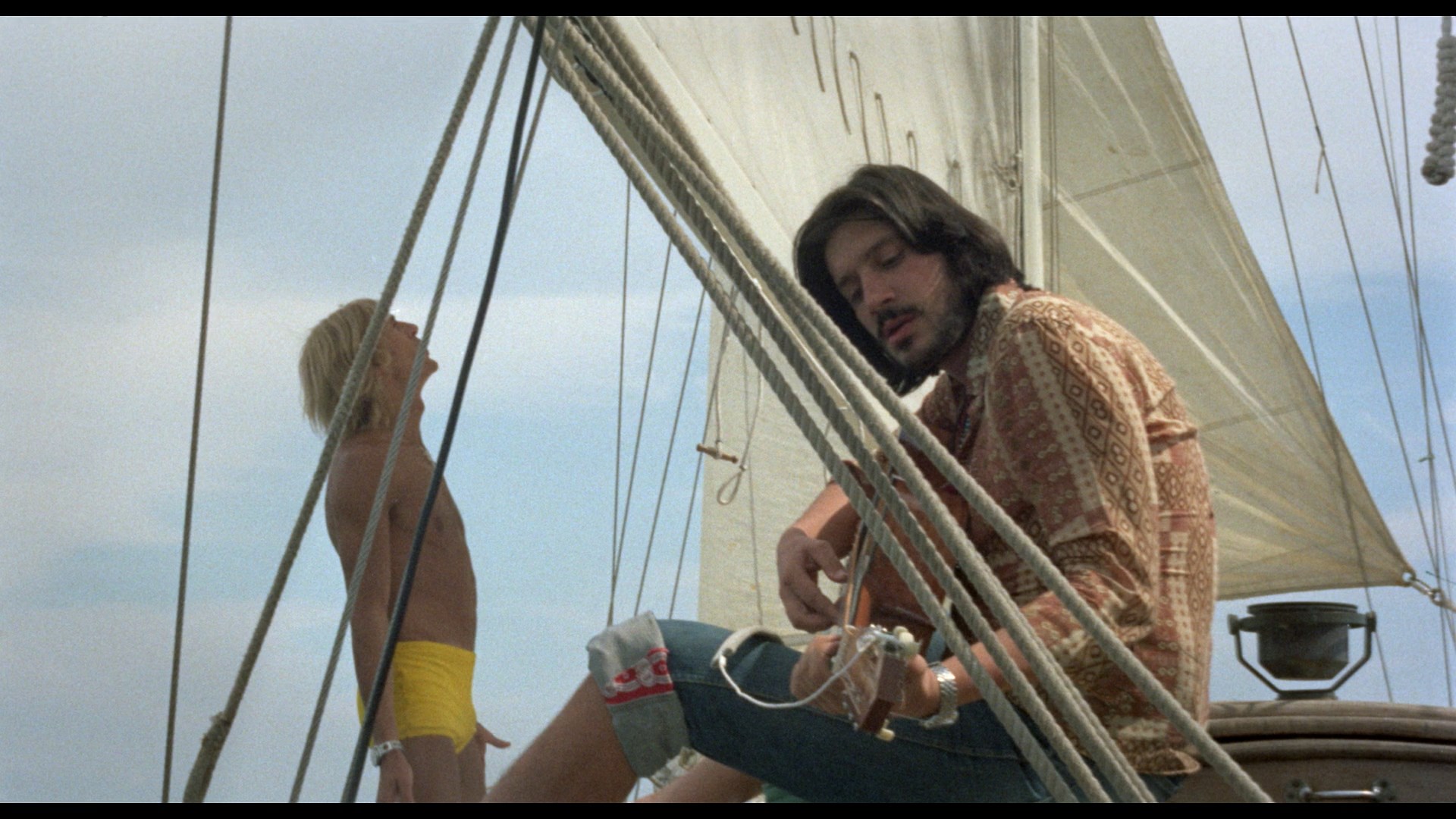 American actress Camille Keaton actually got her start in the early '70s in Italy where she made six films in
American actress Camille Keaton actually got her start in the early '70s in Italy where she made six films in 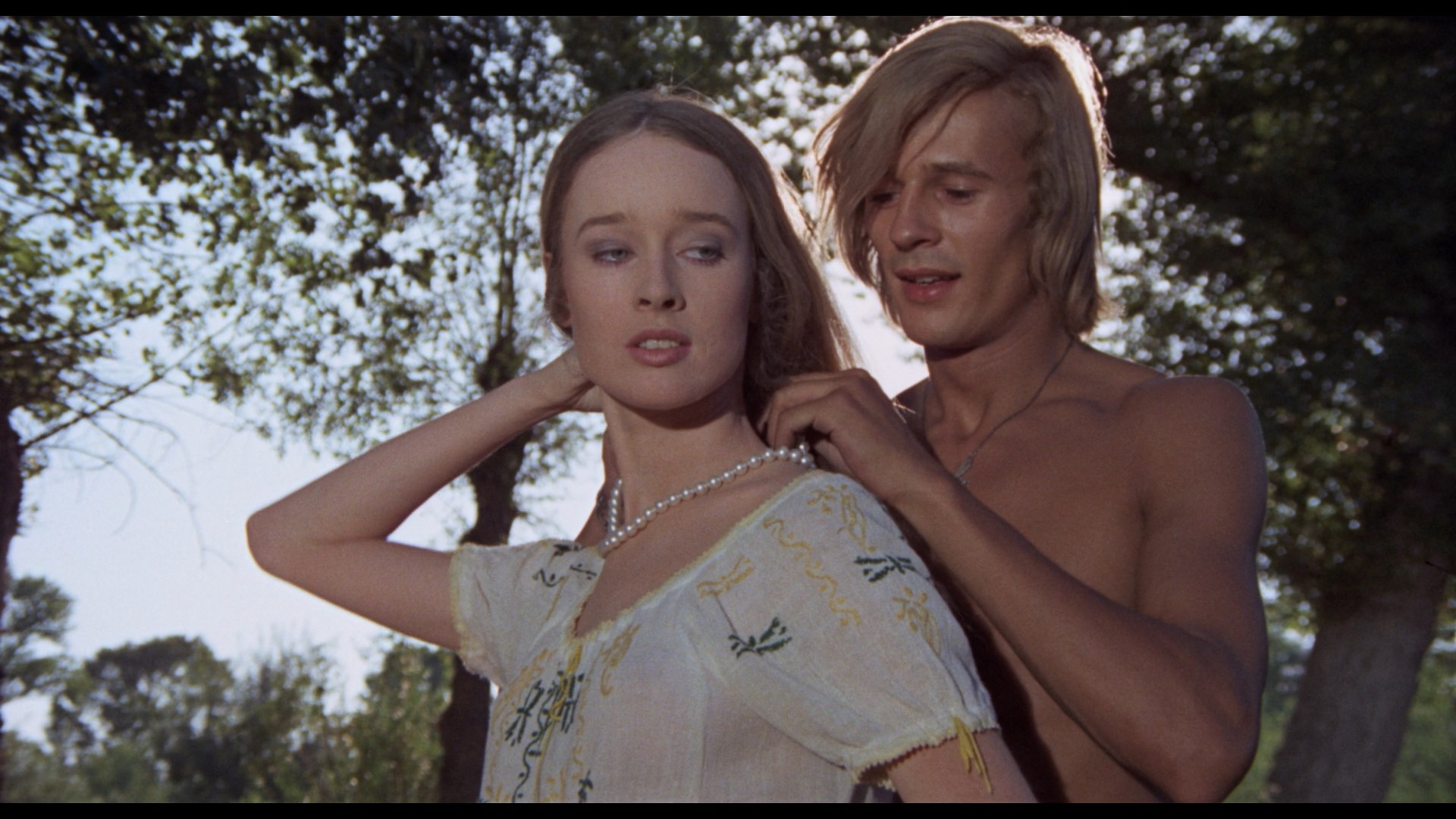 rapid succession. The most widely seen of these is her debut, What Have You Done to Solange?, in which she plays a silent but very pivotal role making great use of her expressive face. That same year she had a far larger leading role in Tragic Ceremony, part of a spate of horror and thriller films from Italy grappling with the severe generation gap that was also leading to what felt like a kind of class warfare in the works. Spiritually akin to contemporaries like An Ideal Place to Kill and Queens of Evil, this obscure Italian-Spanish co-production from horror trailblazer Riccardo Freda (The Horrible Dr. Hichcock, The Ghost) is an oddball Gothic potboiler that never received much of a theatrical release in Europe (or anywhere else). Even in an age filled with neglected titles plucked from the jaws of oblivion, Tragic Ceremony (a.k.a. Tragic Ceremony at Villa Alexander, or in Italian, Estratto dagli archivi segreti della polizia di una capitale europea, translated as From the Secret Police Archives of a European Capital) has had a tough time winning converts unaccustomed to the bizarre state of Italian horror moving into the 1970s.
rapid succession. The most widely seen of these is her debut, What Have You Done to Solange?, in which she plays a silent but very pivotal role making great use of her expressive face. That same year she had a far larger leading role in Tragic Ceremony, part of a spate of horror and thriller films from Italy grappling with the severe generation gap that was also leading to what felt like a kind of class warfare in the works. Spiritually akin to contemporaries like An Ideal Place to Kill and Queens of Evil, this obscure Italian-Spanish co-production from horror trailblazer Riccardo Freda (The Horrible Dr. Hichcock, The Ghost) is an oddball Gothic potboiler that never received much of a theatrical release in Europe (or anywhere else). Even in an age filled with neglected titles plucked from the jaws of oblivion, Tragic Ceremony (a.k.a. Tragic Ceremony at Villa Alexander, or in Italian, Estratto dagli archivi segreti della polizia di una capitale europea, translated as From the Secret Police Archives of a European Capital) has had a tough time winning converts unaccustomed to the bizarre state of Italian horror moving into the 1970s.
A vacation of sailing and exploring for pretty Jane (Keaton) and three of her freewheeling young friends -- Bill (Isbert), Joe (Valverde), and Fred (Petrucci) -- takes a turn for the worse when they wind up stranded in the countryside during a dune buggy expedition. They find refuge at a remote palatial estate run by 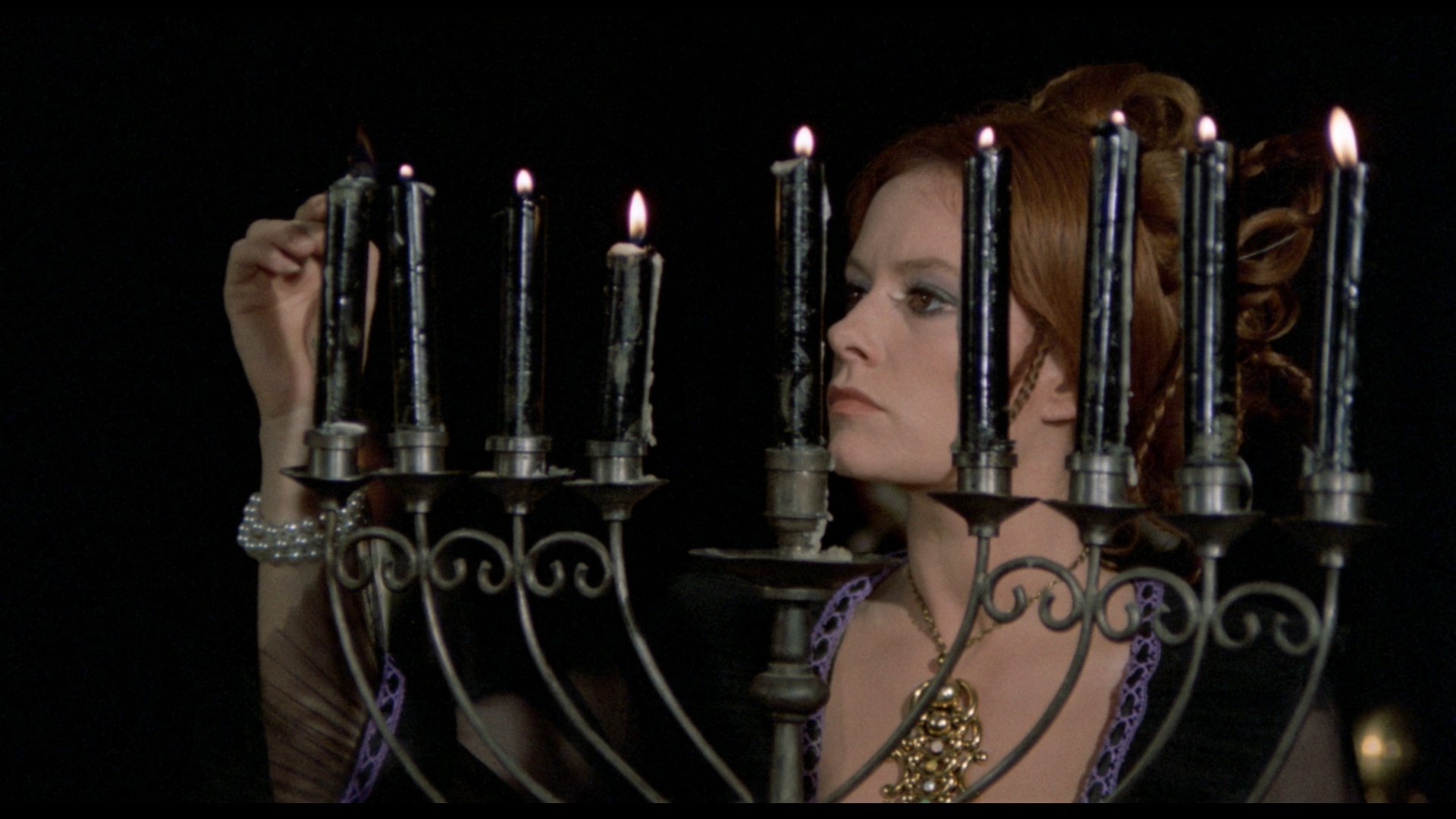 Lord and Lady Alexander (Twitch of the Death Nerve's Pistilli and Thunderball's Paluzzi), a peculiar noble couple hosting some friends for the evening. That night Jane finds her sleep interrupted by strange noises, and as she drifts through the mansion by candlelight, she
Lord and Lady Alexander (Twitch of the Death Nerve's Pistilli and Thunderball's Paluzzi), a peculiar noble couple hosting some friends for the evening. That night Jane finds her sleep interrupted by strange noises, and as she drifts through the mansion by candlelight, she 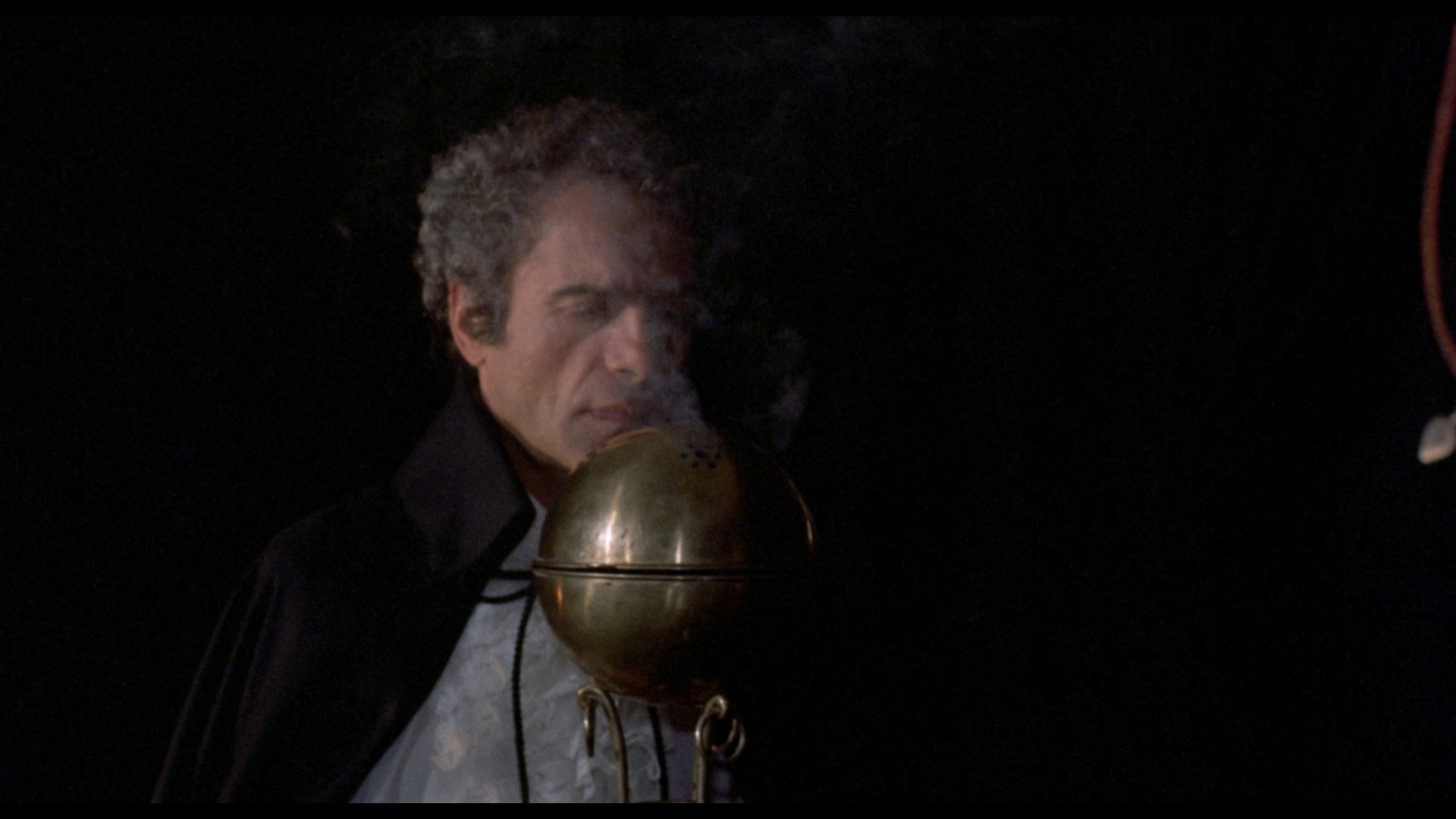 happens upon her hosts engaging in some Satanic devilry that quickly turns into a potential sacrifice. Much graphic bloodshed ensues, with Jane and company fleeing for their lives into the night. But the nightmare is far from over...
happens upon her hosts engaging in some Satanic devilry that quickly turns into a potential sacrifice. Much graphic bloodshed ensues, with Jane and company fleeing for their lives into the night. But the nightmare is far from over...
Lurching between '60s style Gothic atmosphere, Jess Franco-style reality bending and possessions, and trendy gore (including one outrageous cranium splitting), Tragic Ceremony doesn't do much to advance its director's artistic growth but does represent a weird collision between the rigorous formalism of his Gothic classics and the surreal nastiness of his last film, Fear (Murder Obsession). (The same could also be said for Freda's sadistic giallo filmed one year earlier, The Iguana with the Tongue of Fire). Keaton looks beautiful and striking as always, though she's more of a reactive presence here than an active protagonist. More interesting are pros Paluzzi and Pistilli, though they only have a comparatively limited amount of screen time. Stelvio Cipriani contributes a typically catchy score, mixing light pop (including a prominent theme song, "La Vita") with his trademark ominous suspense scoring found at the same time in his work for Mario Bava.
Tragic Ceremony first popped up on some English-speaking fans' radars early in the '00s as a bootleg DVD release with custom subtitles from the mystery label "Shoarma," which tried to pass itself off as an Australian release about as convincingly as Full 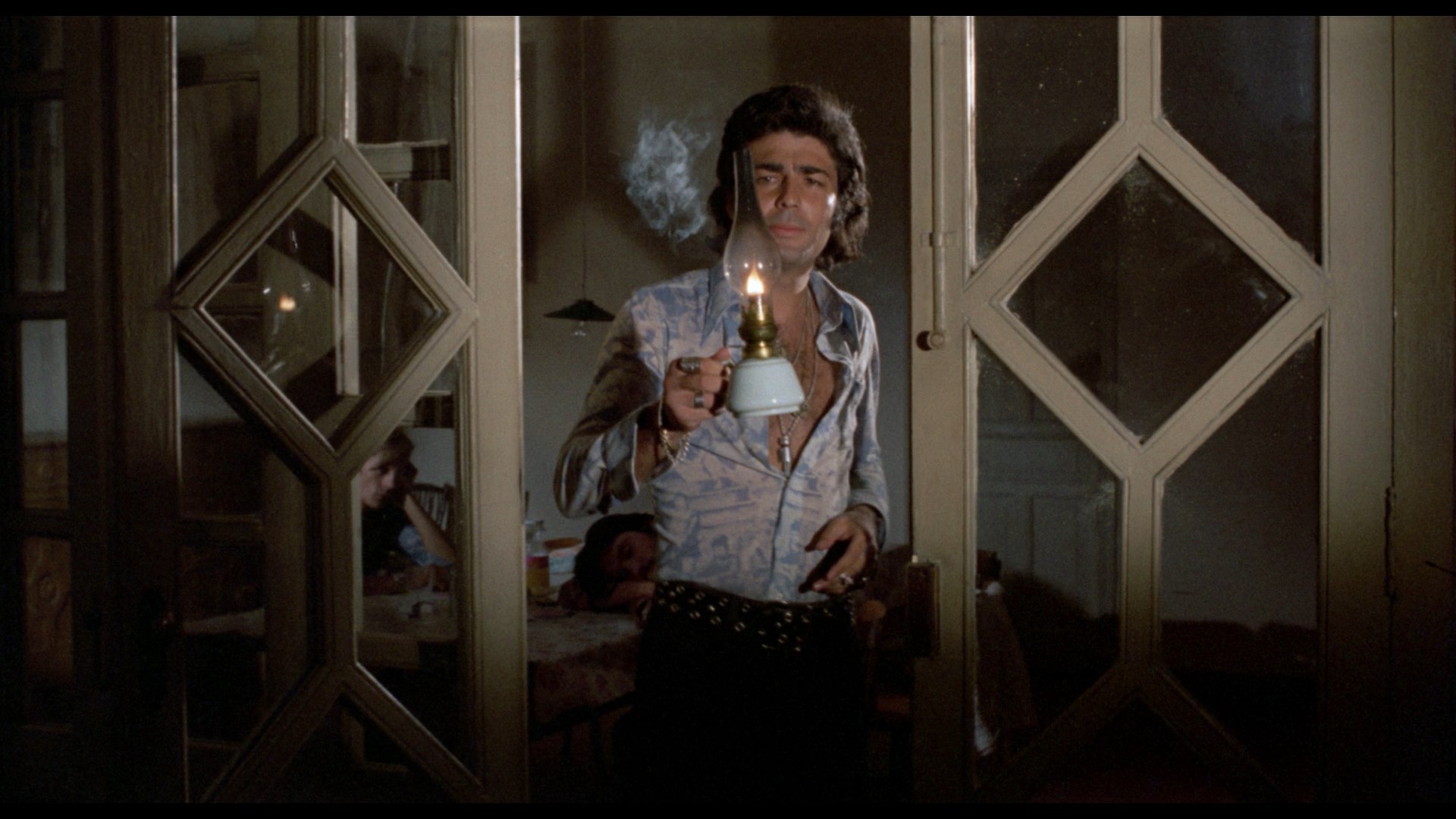 Moon's "Kangaroo Video." Lifted directly
Moon's "Kangaroo Video." Lifted directly 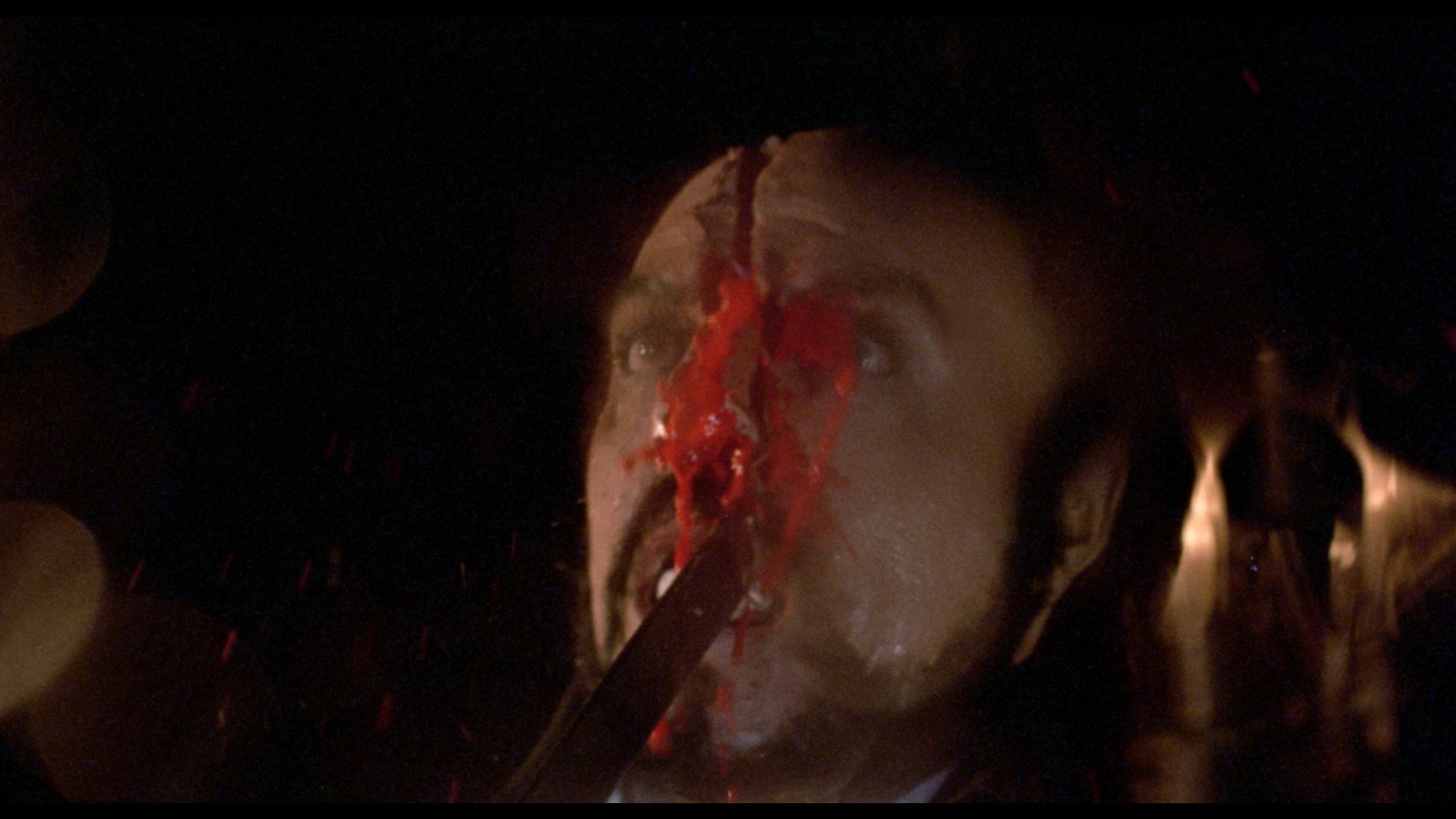 from a cropped Spanish prerecord VHS complete with dropouts and tracking problems, it was a watchable option at the time but left a lot to be desired. Inexplicably, the menu includes an excerpt from Ennio Morricone's The Fifth Cord. Much better was the official DVD debut in 2008 from Dark Sky, taken from a nice 1.85:1 anamorphic master with optional English subtitles and featuring the subtitled Italian trailer plus an enjoyable interview featurette with the star, "Camille's European Adventure" (13m10s), talking about how a car accident just before her move into film impacted her, memories of her cast members and Freda, and her general time learning to embrace life in Italy (as well as running into Paluzzi years later at Hollywood Park in L.A., of all places). She also mentions wanting to do a role for Tinto Brass, which would've really been something. The interview was conducted by longtime friend and Ultraviolent editor Art Ettinger, whose name you'll see again in just a moment; he also conducted the lone comprehensive interview about her European career for his magazine, which is well worth checking out.
from a cropped Spanish prerecord VHS complete with dropouts and tracking problems, it was a watchable option at the time but left a lot to be desired. Inexplicably, the menu includes an excerpt from Ennio Morricone's The Fifth Cord. Much better was the official DVD debut in 2008 from Dark Sky, taken from a nice 1.85:1 anamorphic master with optional English subtitles and featuring the subtitled Italian trailer plus an enjoyable interview featurette with the star, "Camille's European Adventure" (13m10s), talking about how a car accident just before her move into film impacted her, memories of her cast members and Freda, and her general time learning to embrace life in Italy (as well as running into Paluzzi years later at Hollywood Park in L.A., of all places). She also mentions wanting to do a role for Tinto Brass, which would've really been something. The interview was conducted by longtime friend and Ultraviolent editor Art Ettinger, whose name you'll see again in just a moment; he also conducted the lone comprehensive interview about her European career for his magazine, which is well worth checking out.
In 2021, Vinegar Syndrome gave Tragic Ceremony its global Blu-ray debut as part of a very welcome three-disc Camille Keaton in Italy set, with this one marking the only title previously available in the U.S. (or any English-speaking territory, for that matter). Restored in 2K from the 35mm original camera negative, the film looks immaculate here with a colorful and crisp presentation that advances quite a bit over the old DVD. Though Keaton delivered her dialogue in English, the film was only prepared in Italian and is presented that way here with a solid DTS-HD MA 2.0 mono mix (with optional yellow English subtitles) plus the usual lossy Dolby Digital track tucked away for some reason. The archival Keaton featurette is ported over here, but you also get a new audio commentary by Samm Deighan; things start off a bit bumpy as she keeps attributing the film's obscurity to only being available via bootleg(?), but she settles into her groove soon after parsing out how the film subverts genre expectations, similarities to other unorthodox '70s Euro horror titles, highlights from the actors' careers, the gory contributions of Carlo Rambaldi, the participation of writer Mario Bianchi (and his gloriously sleazy directorial career), and her insights into the peculiar family dynamics and class conflicts woven into the story. Finally you get a pretty amazing gallery (3m38s) of modeling shots from Keaton's time in Italy along with a few film promo shots, all provided by Ettinger; the same gallery is repeated on the other two discs as well.
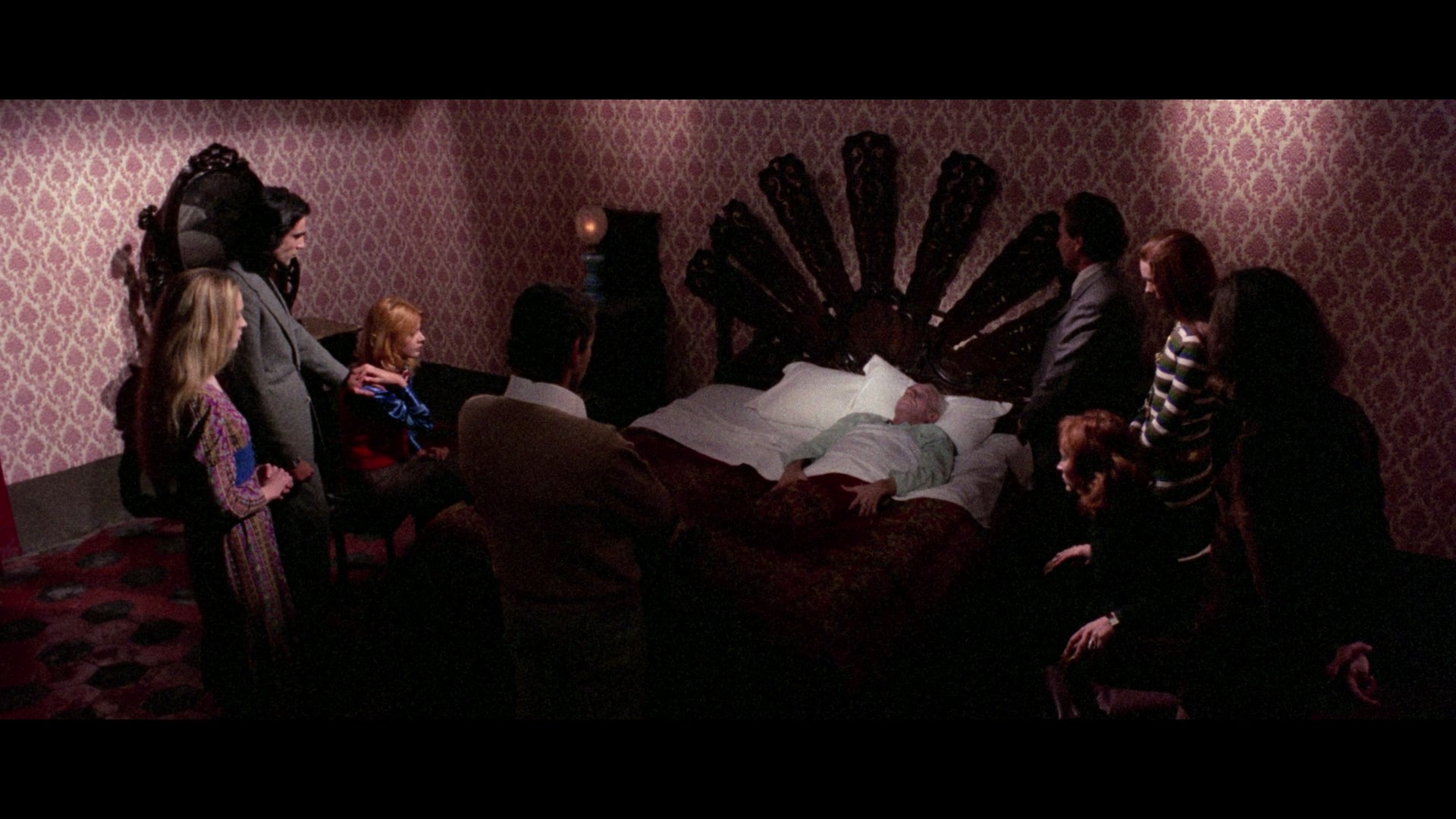 The following year in 1973, Keaton took another horror role for
The following year in 1973, Keaton took another horror role for 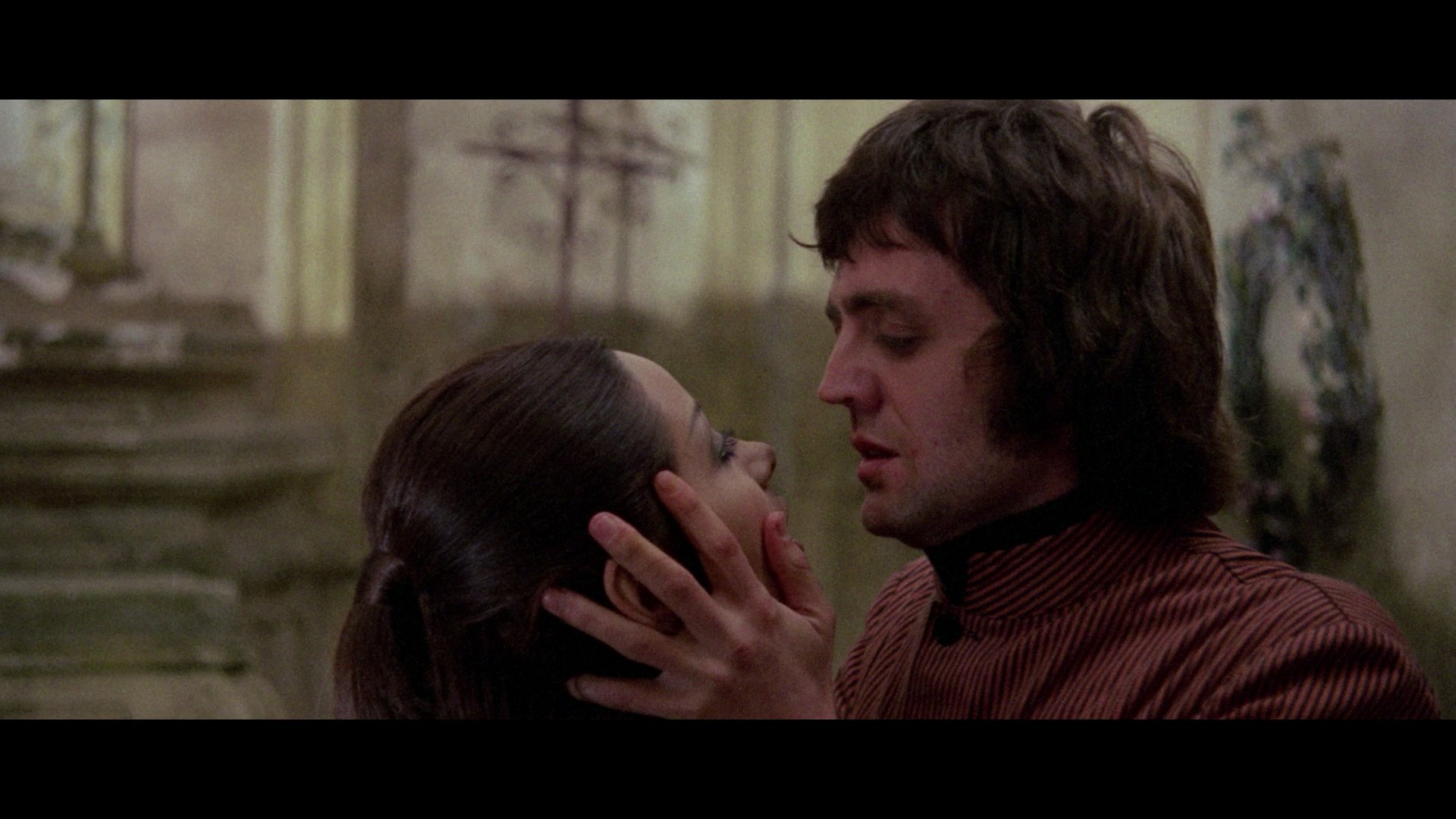 which she provided the eye-catching painted key art: Il sesso della Strega, or The Sex of the Witch. Once again you get a riff on Gothic horror tropes, here the whole "relatives get together in a spooky place for an inheritance," but given a heavy softcore sex makeover accentuated even further by the previously unseen extended cut present on Vinegar Syndrome's Blu-ray. With about ten minutes of extra naked bumping and grinding, it's quite an eyeful and an early example of how adult cinema was really starting to infiltrate the horror genre at light speed around that time.
which she provided the eye-catching painted key art: Il sesso della Strega, or The Sex of the Witch. Once again you get a riff on Gothic horror tropes, here the whole "relatives get together in a spooky place for an inheritance," but given a heavy softcore sex makeover accentuated even further by the previously unseen extended cut present on Vinegar Syndrome's Blu-ray. With about ten minutes of extra naked bumping and grinding, it's quite an eyeful and an early example of how adult cinema was really starting to infiltrate the horror genre at light speed around that time.
The very fragmented story involves the pandemonium unleashed by the demise of Sir Thomas Hilthon, whose English (ahem) estate has become filled with various relatives and staff members curious to see what will happen next -- and what will be divided among them. His daughter Evelin (So Sweet, So Dead's Dublin) is cut off because of her haughty attitude to her relations, but she also knows about some valuable and dangerous scientific secrets involving her father. Also among the gathering are niece Ann (Keaton) and the deceased's secretary, Simon (Giallo in Venice's Dei), 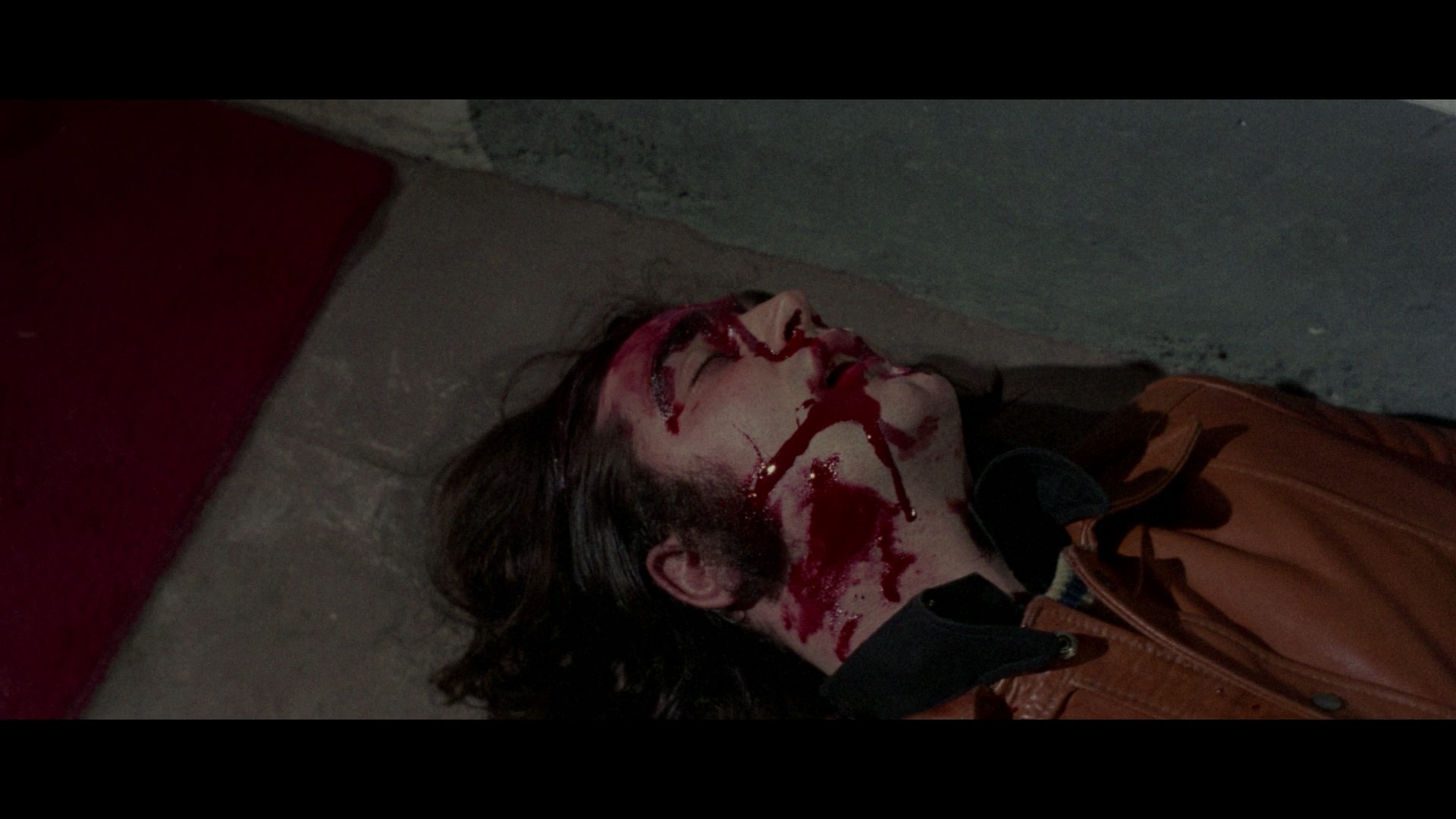 while everyone seems to be sneaking off to dark corners in various female-male combinations to roll around naked in beds, crypts, or whatever other surface might be handy.
while everyone seems to be sneaking off to dark corners in various female-male combinations to roll around naked in beds, crypts, or whatever other surface might be handy. 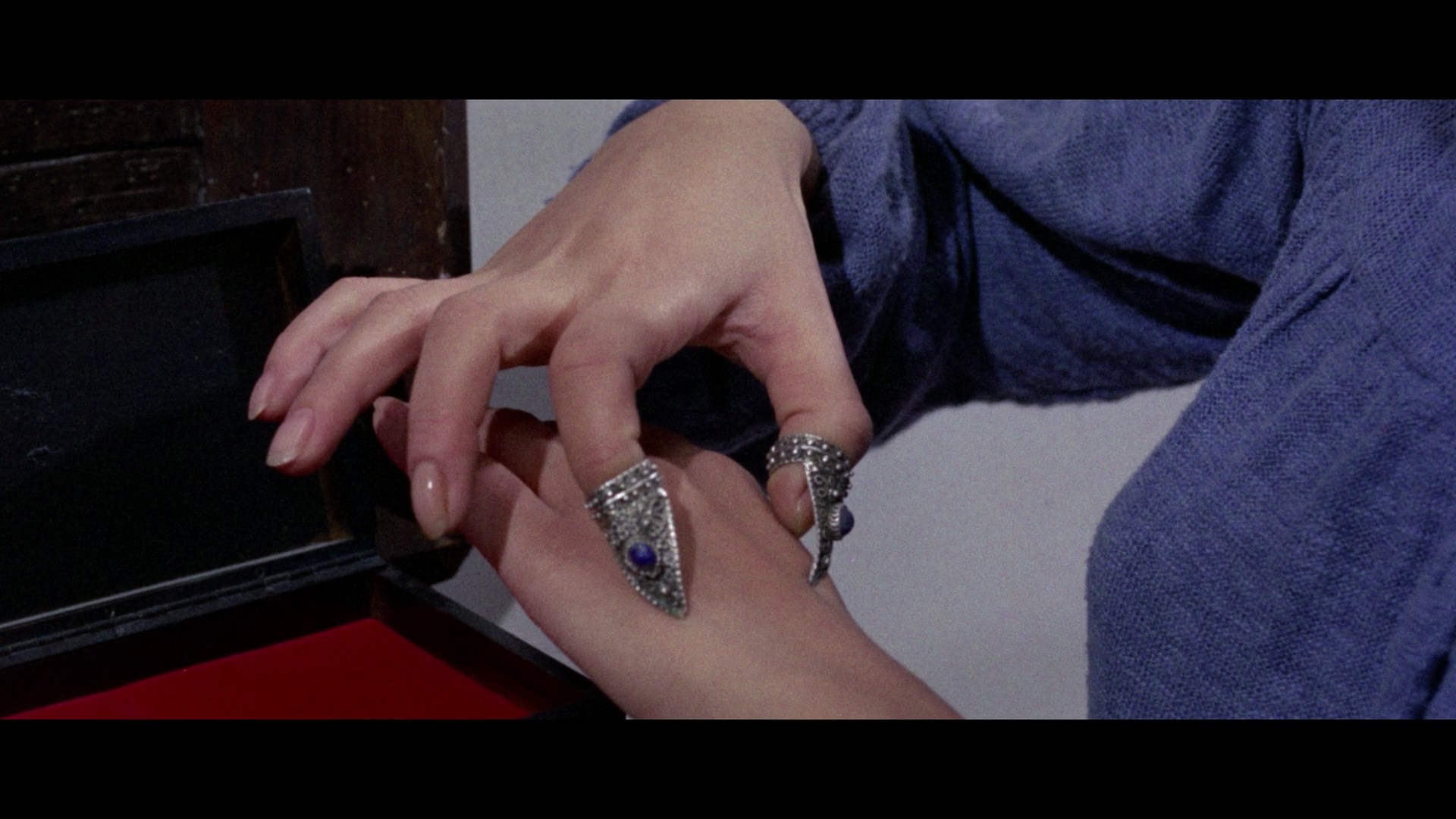 Soon someone's running around at night whacking people to death with mallets and wielding a creepy spiked ring, which sends the police in (represented by busy character actor Donald O'Brien) to get to the bottom of the mystery.
Soon someone's running around at night whacking people to death with mallets and wielding a creepy spiked ring, which sends the police in (represented by busy character actor Donald O'Brien) to get to the bottom of the mystery.
Though it barely hangs together on a linear mystery level at all, Sex of the Witch is quite the experience if you're looking for a sex and violence bash with some wild plot twists (the killer's identity is a doozy!) and familiar faces letting it all hang out including Hell of the Living Dead's memorable eccentric Franco Garofalo (credited as "Christopher Oaks"), who gets to indulge in the longest and most explicit sex scenes. Keaton steps back into a supporting role here but still makes an impression in one eerie bed scene, and it's all loaded with that widescreen Gothic juiciness we know and love from the period even with a clearly threadbare budget under the guidance of writer-director Angelo Pannacciò (who went on to The Return of the Exorcist and some early '80s hardcore films). However, the real star here might be composer Daniele Patucchi, who unleashes a wonderful score mixing catchy easy listening 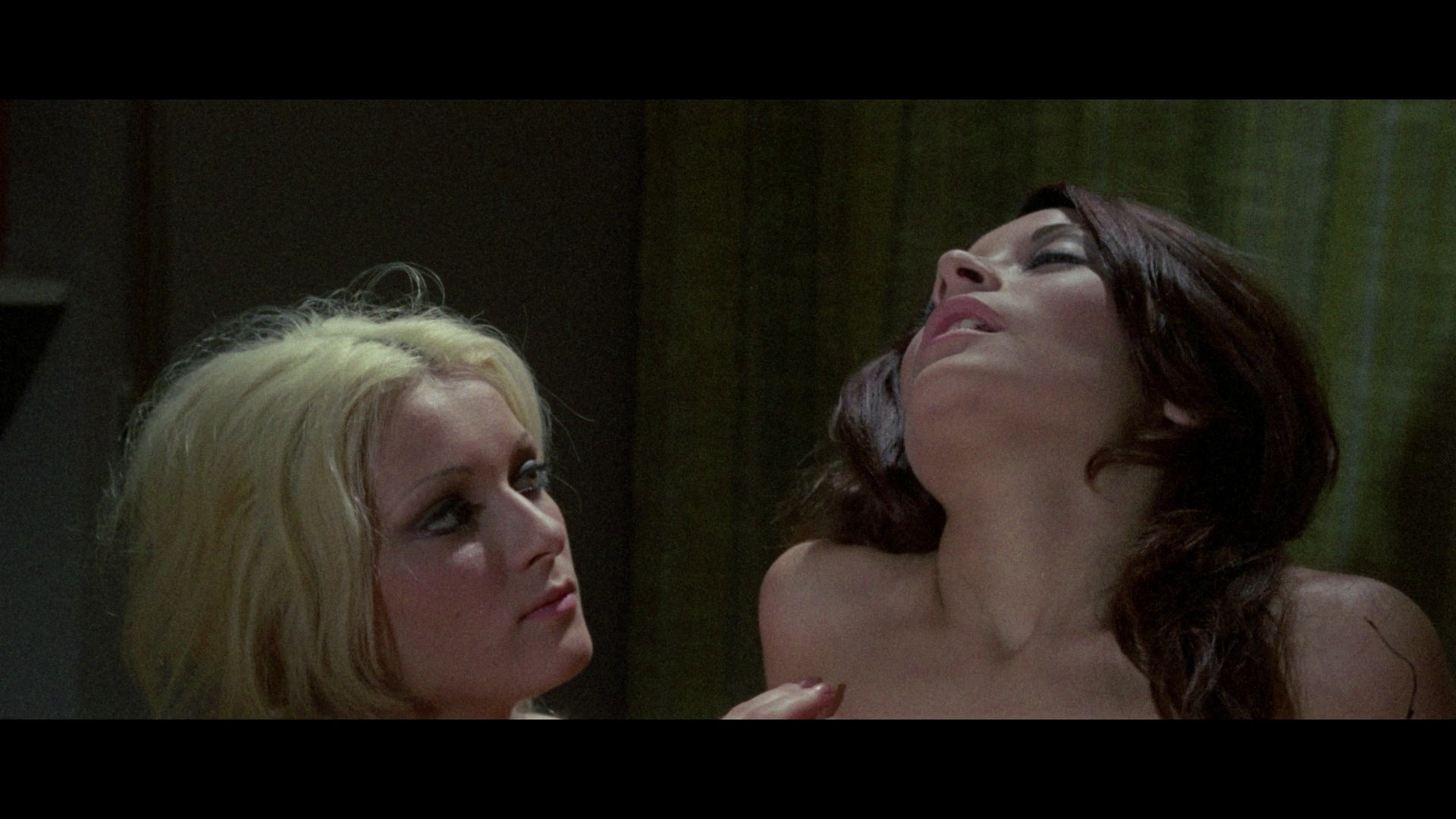 ditties with darker, delirious suspense music that sounds like a forerunner
ditties with darker, delirious suspense music that sounds like a forerunner 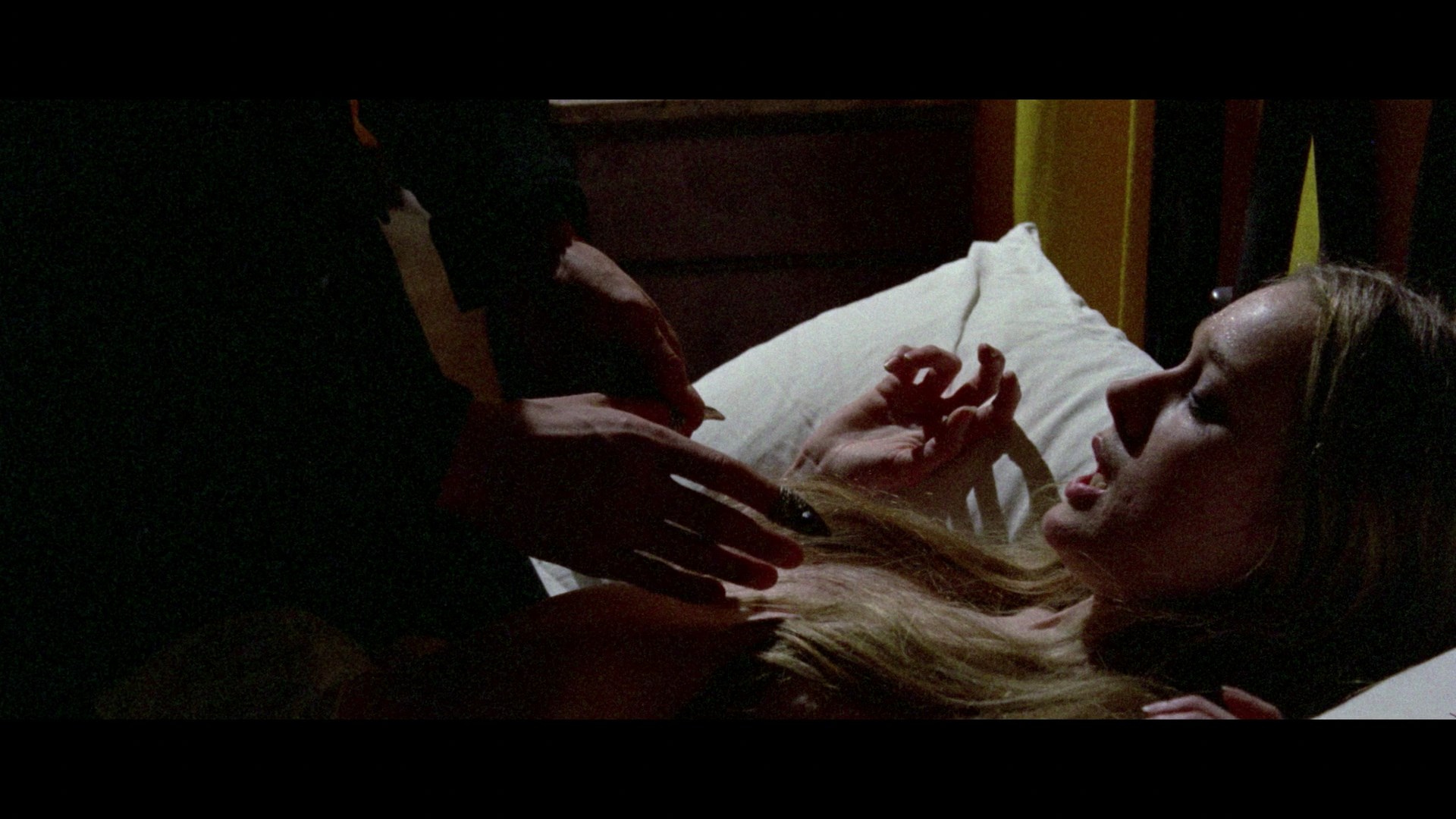 to The Stendhal Syndrome.
to The Stendhal Syndrome.
Apart from a very brief Italian DVD release from Cinekult (of the edited theatrical cut with no other language options), Sex of the Witch has been ignored on the legitimate home video circuit until this Blu-ray release. Again it was evidently only prepared in Italian, so that's what you get here with the DTS-HD MA 2.0 mono option sounding quite nice and sporting optional yellow English subtitles. As mentioned above, this 2K scan from the camera negative is completely uncut with all of the copious flesh finally reinstated for maximum entertainment value. A new audio commentary by Kat Ellinger starts off with a thorough appraisal of uncredited writer Franco Brocani (Necropolis) and parses through the existing production info about the film (first chronicled by Robert Curti) before going into the histories and tropes of both the giallo and Gothic narratives, often with a bemused comment about the confused reactions likely to be elicited from most viewers. The long, incoherent Italian trailer is also included here (with subtitles), offering a pretty good clue why this film died so quickly at the box office.
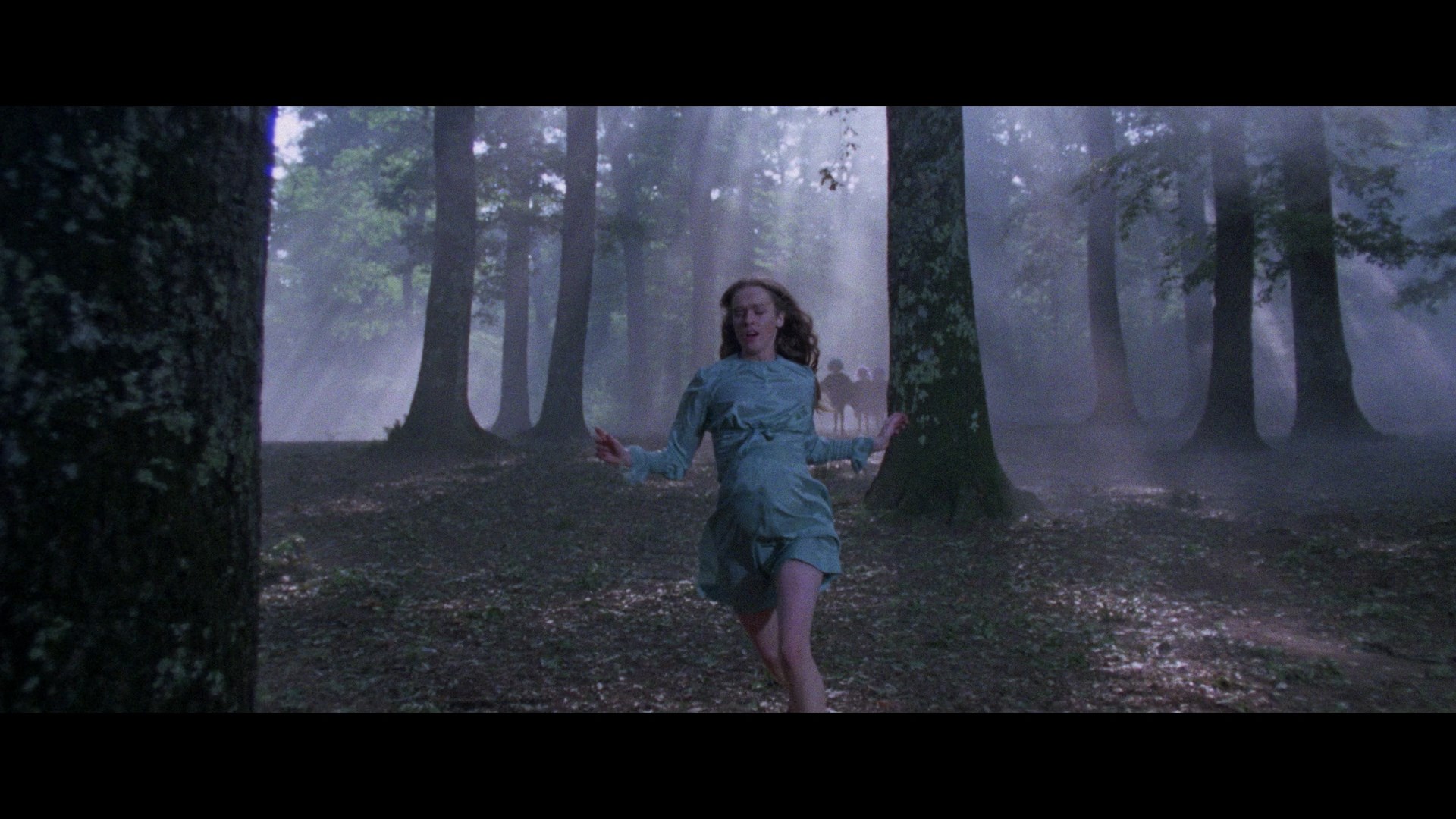 Finally we reach Keaton's personal favorite film of her
Finally we reach Keaton's personal favorite film of her 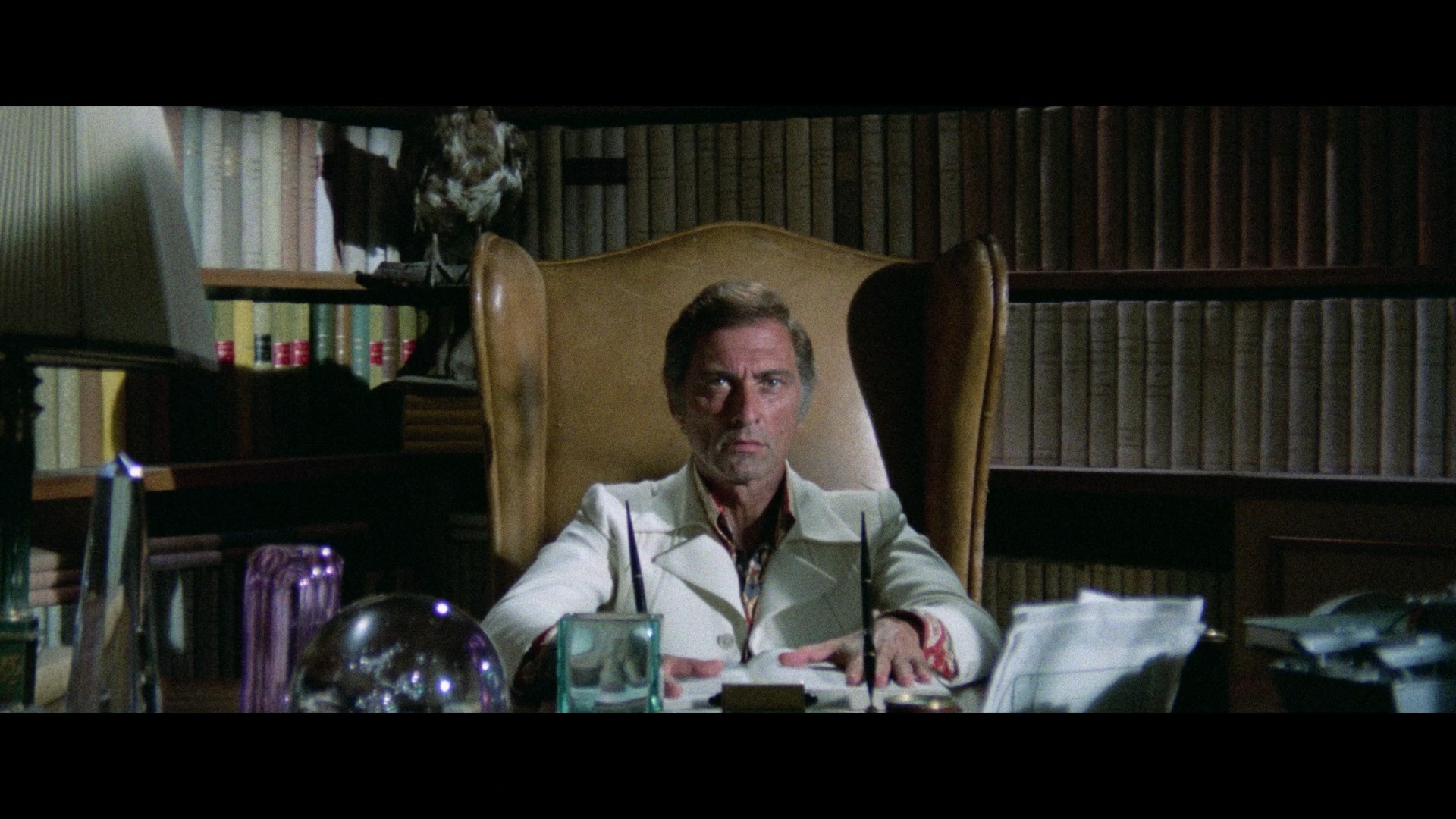 entire output and the one that strays furthest from the horror genre here: 1974's Madeleine: Anatomy of a Nightmare (or Madeleine, anatomia di un incubo), which would be her final Italian production as well as her last film for four years until her career-defining role in I Spit on Your Grave. Previously available only in custom-subtitled gray market editions from a cropped, very dupey Italian VHS, this one is a real revelation on Blu-ray with its elusive English-language track (featuring Keaton's own performance intact, even if she was looped afterward) finally available for the first time ever. It's a strange and haunting art film with heavy macabre overtones, giving its star a great showcase to strut her stuff as a thespian far more than her other projects from the same time. It also features an extremely haunting score by pop star Maurizio Vandelli, which was only released on vinyl back in the day but is screaming out for a special edition release one of these days.
entire output and the one that strays furthest from the horror genre here: 1974's Madeleine: Anatomy of a Nightmare (or Madeleine, anatomia di un incubo), which would be her final Italian production as well as her last film for four years until her career-defining role in I Spit on Your Grave. Previously available only in custom-subtitled gray market editions from a cropped, very dupey Italian VHS, this one is a real revelation on Blu-ray with its elusive English-language track (featuring Keaton's own performance intact, even if she was looped afterward) finally available for the first time ever. It's a strange and haunting art film with heavy macabre overtones, giving its star a great showcase to strut her stuff as a thespian far more than her other projects from the same time. It also features an extremely haunting score by pop star Maurizio Vandelli, which was only released on vinyl back in the day but is screaming out for a special edition release one of these days.
In a protracted opening nightmare sequence, a pregnant Madeleine (Keaton) is pursued through a daylit forest by a group of sinister women in brightly dyed wigs-- which segues into flashes of a fiery race car crash and a baby doll consumed by flames. This turns out to be the latest in a series of subconscious traumas brought about by her recent miscarriage, which her vet doctor husband, Franz (Castle of Blood's 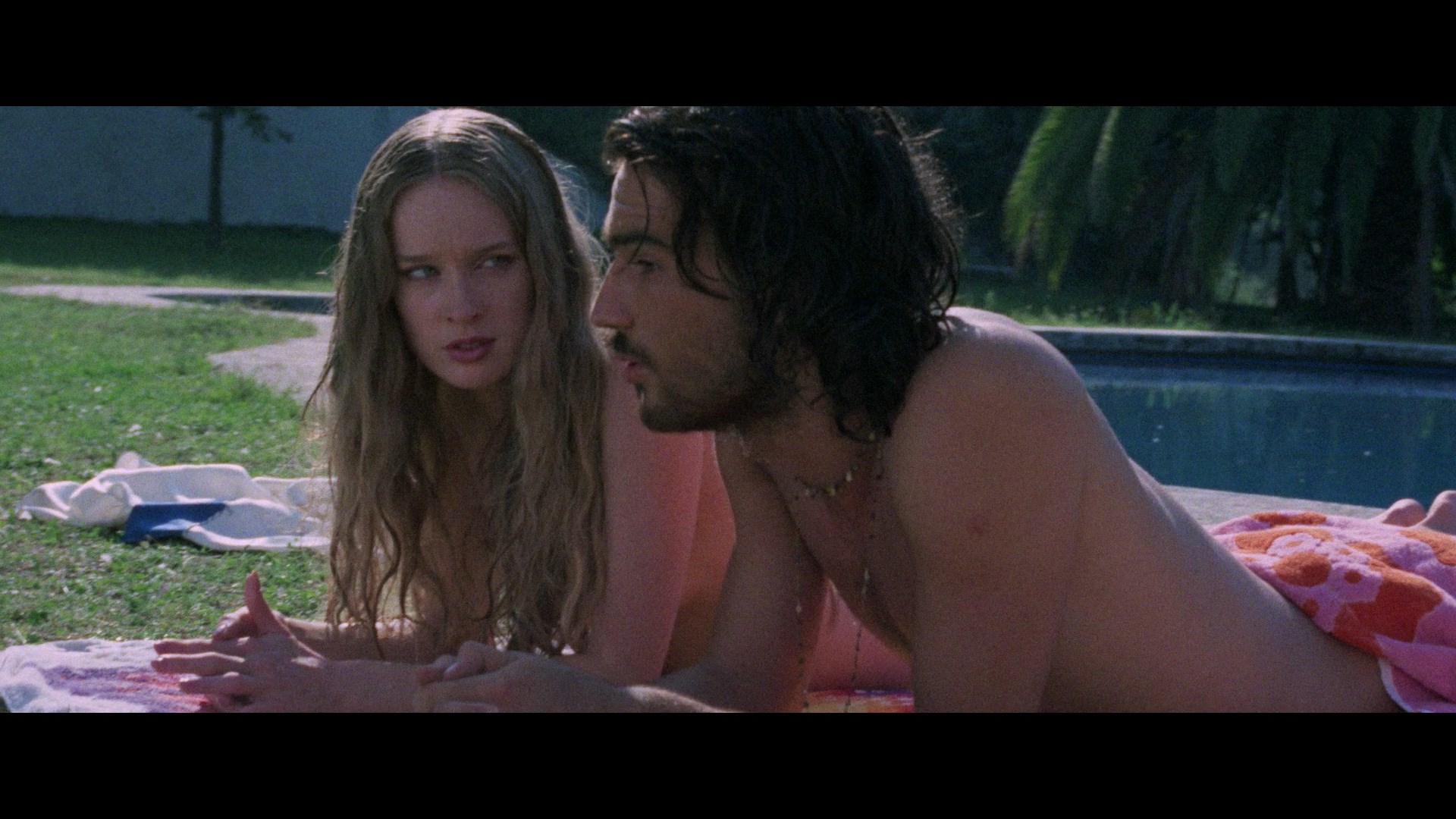 Tranquilli) tries to unravel while
Tranquilli) tries to unravel while 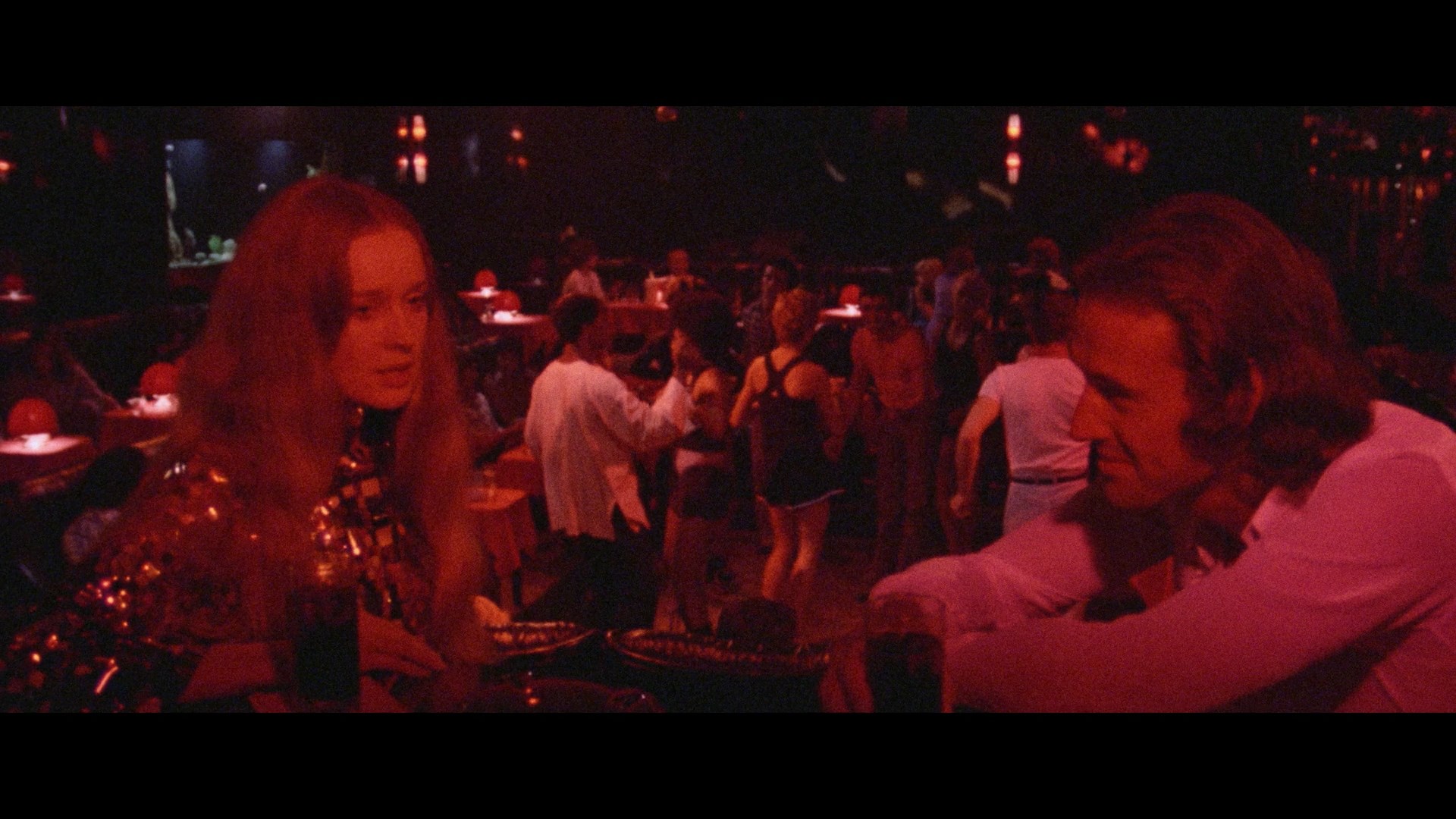 reading parapsychology books by the swimming pool and helping horses give birth under hypnosis. Filling her days wandering around Rome, Madeleine is further disoriented when her stepson, racer Luis (Emanuelle in America's Salvino), comes for a visit from Paris, and she strikes up an affair with Thomas (Cry of a Prostitute's Rossi), a Geneva student studying philosophy in Italy. Gradually her psyche seems to unravel as she tries to sort out her feelings of torment and unpredictable sexuality, all speeding her (and the audience) to a radical twist ending.
reading parapsychology books by the swimming pool and helping horses give birth under hypnosis. Filling her days wandering around Rome, Madeleine is further disoriented when her stepson, racer Luis (Emanuelle in America's Salvino), comes for a visit from Paris, and she strikes up an affair with Thomas (Cry of a Prostitute's Rossi), a Geneva student studying philosophy in Italy. Gradually her psyche seems to unravel as she tries to sort out her feelings of torment and unpredictable sexuality, all speeding her (and the audience) to a radical twist ending.
Trying to place Madeleine into any kind of genre bucket is tricky since it has elements of avant-garde art film, hallucinatory horror, sexy melodrama, and most obviously, a case study in dark female psychology a la Symptoms, Images, and so on, albeit with a far less homicidal bent here. Actor-turned-director Roberto Mauri (who showed his range, to put it mildly, with King of Kong Island and a handful of peplum and spaghetti western films) keeps things visually interesting with the line between dreams and reality never quite clear throughout, and it's beautifully shot in Techniscope by ace cinematographer Carlo Carlini (I Vitelloni, Autopsy). The film isn't really exploitation at all apart from some artistic nudity here and there, though trash movie lovers will love the appearance of Paola Senatore (Images in a Convent, Salon Kitty), who stops the show here in what amounts to a one-scene sequence at a nighttime pool party that could virtually be 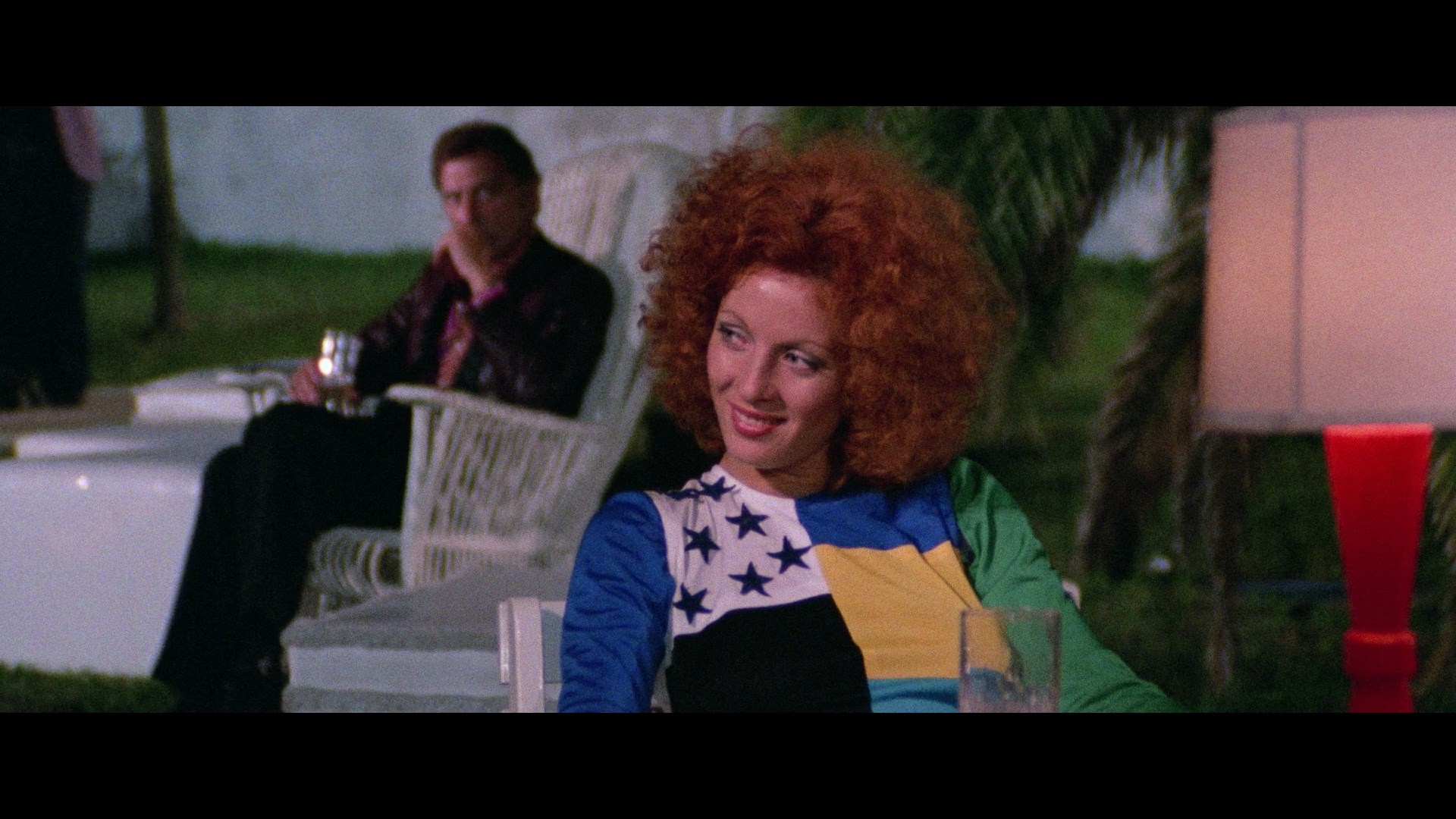 a short film all unto
a short film all unto 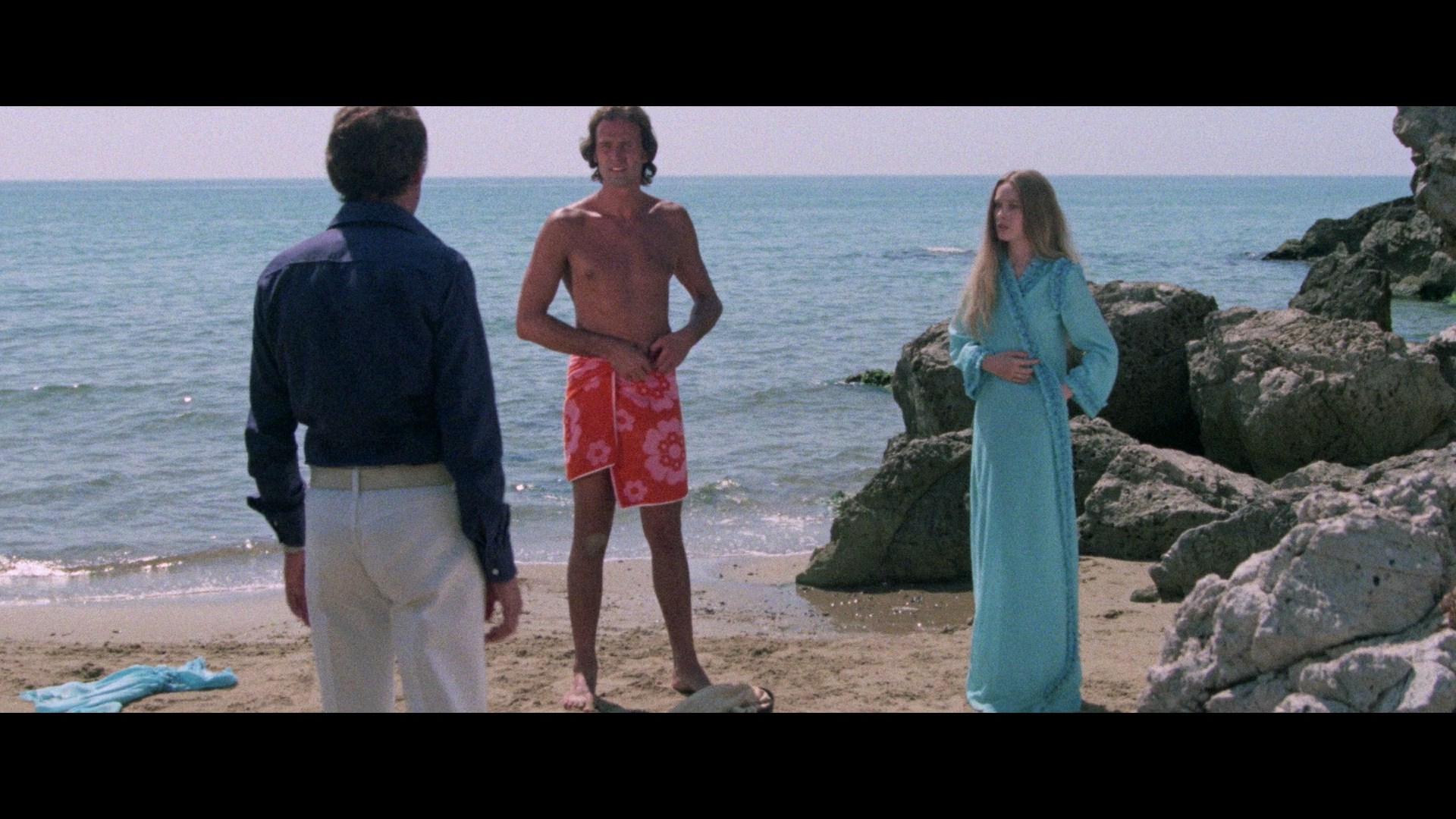 itself.
itself.
A worthy edition of Madeleine has been a long time coming, and that's what we finally get here with a beautiful transfer from a 4K scan of the original camera negative. It looks really fabulous all around with organic film grain intact and some striking, saturated color schemes where required. The English track is presented in DTS-HD MA 2.0 and Dolby Digital mono; however, note that while there are no setup options on the menu, there are two subtitle tracks here. The first translates some Italian text and, most crucially, some brief dialogue exclusive to the Italian track -- essential here since that's the final two lines of dialogue. At least for this review, that subtitle track didn't pop up automatically so make sure you manually switch it on. The second option provides standard, yellow English SDH subtitles. Keaton herself turns up here to chat with Ettinger for a very warm, cheerful audio commentary that covers her initial move to Italy, her particular affection for this film, the experience of having to drive on-camera around Italy, the credentials of her fellow actors, the challenges of speaking English on these productions, Senatore's rough personal fortunes in the '80s, and plenty more. Keaton also turns up on camera for "Passport to Kill" (26m12s), a new featurette with a more general overview of her Italian career starting with her upbringing in Arkansas and initial fascination with movie stardom and then moving through her key films including all of the ones represented in this set. She also goes into her American work and current activities, including a shout out to the fans who have kept her films alive. It seems Ettinger conducted this interview as well based on references from the commentary, though he's uncredited here for some reason. A new audio essay by Rachael Nisbet (23m11s) takes an analytical look at the film as part of a wave of ambitious films that took a frequently experimental approach to eroticism and psychodramas, with background about the director and cast giving a handy overview of the paths that led to this particular project. Finally the disc closes out with the English trailer and an alternate 3m14s burning baby nightmare sequence pulled from the Italian VHS.
Reviewed on November 8, 2021
![]()